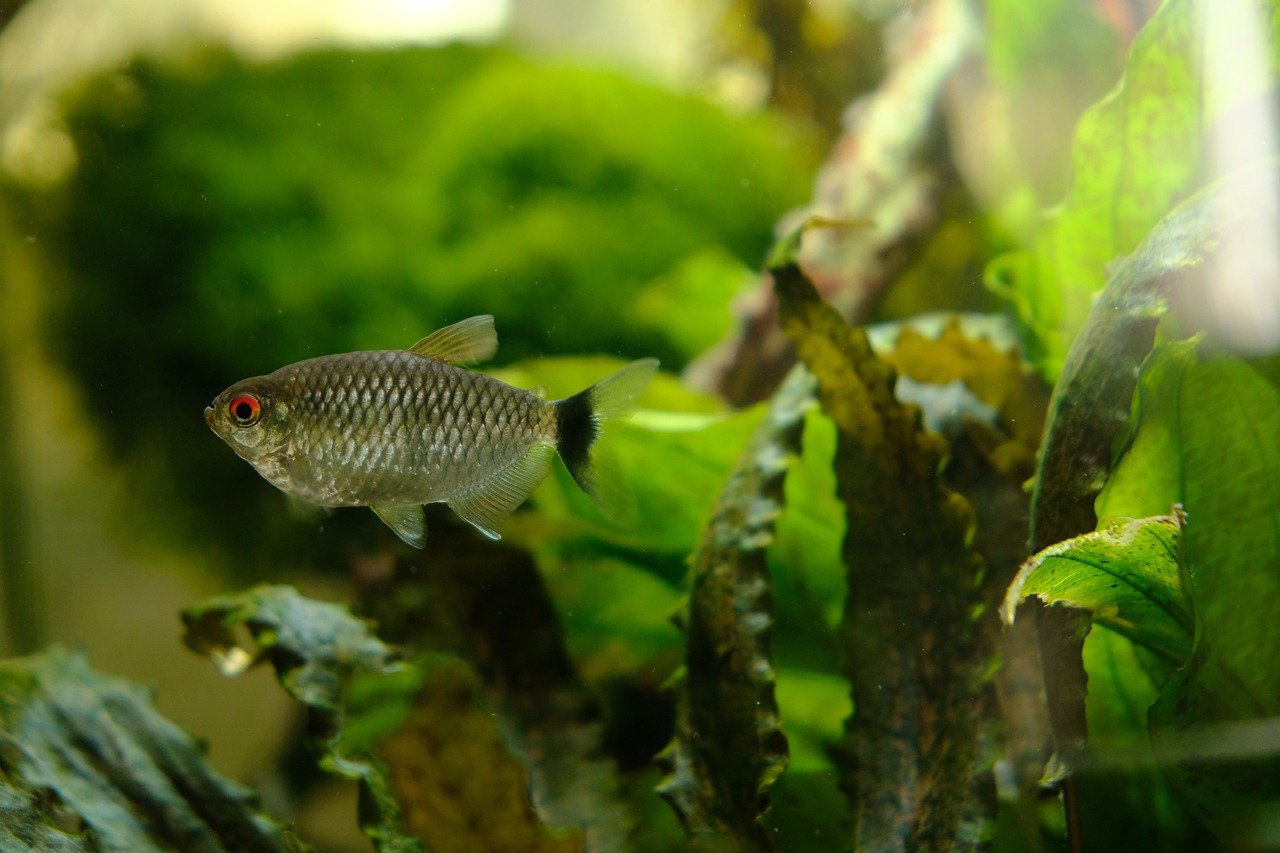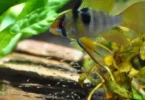Last Updated on February 10, 2023 by Matt
Along with ammonia and nitrite, nitrate is one of the inorganic forms of nitrogen formed during the nitrogen cycle. But unlike these compounds, nitrate can be found at a reasonable concentration in aquariums without causing problems. But issues do occur when the aquarium nitrate concentration gets too high. Nitrate poisoning can be a huge problem when the nitrate levels in a fish tank rise too high.
Nitrate poisoning is common in newbie tanks but can also happen at the mature tank stage too. Given this level in the aquarium becomes dangerous, its important you act fast to save your aquarium fish and aquarium plants.
But what is nitrate poisoning? In this article we will talk about the signs and symptoms of nitrate poisoning, and what you can do about it.
IN THIS ARTICLE
What Is Nitrate Poisoning Exactly?

Nitrate poisoning occurs when the concentration of nitrate in the water level rises to, and remains at, dangerously high levels. It is the chronic form of nitrate toxicity.
Nitrate poisoning is very serious and steps need to be taken quickly to reduce the levels of nitrate in the tank. If you don’t take steps to reduce nitrate to normal and healthy levels then your fish will eventually die.
There is another form of nitrate poisoning, called nitrate shock. Nitrate shock occurs when the nitrate levels in the tank spike, or suddenly rise in concentration. Nitrate shock is the acute form of nitrate toxicity, but is no less dangerous.
Saying this, nitrate shock can also occur when the nitrate concentration drops suddenly. Remember that fish, especially tropical fish, need consistent conditions to remain healthy. Any change, rise or fall, can have ill effects.
How affected fish are by nitrate levels depends on the species, as well as their development stage. Saltwater fish are in general more susceptible to lower levels of nitrate than freshwater fish. This is because naturally there is more nitrate found in freshwater ecosystems. Young fish, and fry, are much more susceptible to lower nitrate levels than fully grown adult fish. This is due to the effect nitrate has on the body, and the effect on red blood cells.
Signs and Symptoms of Nitrate Poisoning and Shock
Nitrate poisoning can be hard to see the signs of, but fish should exhibit come symptoms. Fish will exhibit symptoms of nitrate shock, where the nitrate levels rise rapidly. When nitrate levels rise very slowly, fish can show very few symptoms until mortalities start occurring.
Nitrate can interfere with the normal activity of red blood cells, and can reduce and restrict the flow of oxygen around the body. Many symptoms are similar to that of low oxygen concentrations. The symptoms you should be on the lookout for in your fish are as follows:
- Rapid gill movement – This is a fish equivalent of short, shallow breathing. It is a sign of fish not having enough oxygen.
- Appetite loss – You should know your fishes behavior around feeding time. If you see sluggishness and appetite loss it is a sign something is wrong.
- Lying on the base of the tank. Lying unmoving on the base of the tank with rapid gill movements is a sure sign of illness.
- Disorientation – Again, you have been watching your fish and know them well. If you see them disorientated it is time to check the water chemistry.
- Curling. If you see your fish curling as if into a ball from head to tail, this can indicate nitrate poisoning in its advanced stage.
These symptoms will be shown by fish who have been exposed to nitrate shock. Nitrate poisoning can be difficult to see, until fish start to die unexpectedly. Nitrate poisoning is the chronic exposure to high levels of nitrate, and this often occurs when nitrate levels rise very gradually, not suddenly as in nitrate shock.
Something that can warn of a rise in nitrate levels is the presence of excess algae. Algae will use the excess nitrate in the water column to fuel growth, and at the sign of excess algal growth you should be checking the water chemistry to ensure that everything is in healthy levels. A good water testing kit such as the API Aquarium Test Kit allows you to test for ammonia and nitrite as well as nitrate. If you have an issue with nitrate you may well have an issue with these compounds too.
Be aware that fish brought into a new aquarium often show signs of nitrate shock. The water chemistry between your aquarium, and that of the store, will be different. As such you need to introduce new fish slowly. If you have an issue with nitrate, wait until it is resolved until purchasing new fish.
Nitrate Poisoning Treatment

There are a number of things that you can do to treat nitrate poisoning. You do need to be careful though. As you might remember, nitrate shock can occur when the nitrate levels suddenly plummet as well as increase suddenly. As such you need to make sure the nitrate levels reduce slowly to a healthy range, so as not to shock their bodies more.
Perhaps the quickest and most effective way of reducing nitrate levels back to a healthy range is to do many small water changes. Water changes can be made easier using a product like the Python water changer. What you don’t want to do is one big water change, as this will remove too much nitrate at once and cause nitrate shock.
Instead many smaller water changes will be very effective. To get an idea of how many water changes you should do, use a testing kit to test both the aquarium water and the replacement water. You want to make it gradual; only about a 10-20 ppm change each time. Water changes of between 5-10% should be fine to do this. Leave 2-3 hours between each water change, to allow your fish to become used to the new water chemistry. Ideally you want to change a total of around 50% of the water. Keep testing the aquarium water, and stop the water changes once the nitrate level is normal. Using RODI water for these water changes is recommended as it won’t contain any extra nitrate.
Whilst you are undertaking the water changes, don’t feed your fish that day. Any excess food will decay and fuel nitrate formation. It isn’t feasible to just stop feeding your fish however. So for the next few days after you have undertaken your water changes only feed your fish the bare minimum. Watch them feed, and allow no waste.
The final thing you can do is to use a biological or chemical filtration media which removes nitrates. Seachem DeNitrate is a great biological filtration option. It is a highly porous filter material which removes nitrate by allowing for anaerobic denitrifying bacteria to grow and proliferate within the structure. If you remember from the nitrogen cycle, denitrifying bacteria convert nitrate to atmospheric nitrogen.
You can also use something like which is a synthetic chemical filtration media which works by adsorption. It doesn’t directly remove nitrate, but instead remove the organic nitrogenous material which would otherwise be broken down to nitrate.
Using biological and chemical media should be able to maintain the level of nitrate that you have managed to get to using small, regular water changes.
Preventing Nitrate Poisoning
Whilst treating nitrate poisoning is completely doable, it is always best to prevent the issue from forming in the first place.
It is important to understand how nitrate enters and is removed from the water column in order to prevent concentrations rising too high.
When waste food and debris in the tank decompose, ammonia is released. Ammonia is converted to nitrite, which is then converted into nitrate by nitrifying bacteria in the biological filter and also within the substrate. The nitrate produced during nitrification is then released into the water column.
Nitrate can be removed in a couple of ways. It is used by plants as a source of nitrogen. Therefore aquarium plants will remove nitrate from the water, using it for their growth.
Nitrate is also removed by denitrifying bacteria in a process called denitrification. Under anaerobic conditions, in the absence of oxygen, it is converted to atmospheric nitrogen.
There are a number of ways you can prevent nitrate levels rising in aquariums:
- Keep live plants in the tank. Plants use nitrate as a source of nitrogen, and will happily remove it from the water column. If you have more plants, then they will use more nitrate. Ideally you want a mix of aquarium plant species; don’t have a monoculture of only one plant species.
- Ensure you have good biological filtration. A good biological aquarium filter will ensure that you have an environment for denitrifying bacteria to thrive. These bacteria convert nitrate to atmospheric nitrogen. Ensuring you have a well maintained biological filter will make sure nitrates are being converted in this way.
- Do not overfeed your fish. If you overfeed, you will increase the amount of waste food which then decomposes. As microbes feed on this organic matter they release ammonia into the tank. This is eventually converted into nitrate. Reducing waste food means you reduce the amount of nitrate produced in the tank.
- Clean your tank regularly. As we have said previously, decaying matter will release ammonia, and will fuel the formation of nitrate in your tank. Regular cleaning and maintenance, especially with a good aquarium vacuum cleaner, will rid your tank of waste.
- Clean the filter regularly. Mechanical filtration media can become clogged with debris, which then begins to decompose. Biological media can also become clogged, and chemical media may need replacing to continue to be effective.
- Don’t overstock your aquarium with fish. Not only is overstocking a tank bad for stress levels; fish won’t have as many places to hide, it is also bad in terms of nitrate. More fish means more waste, more ammonia produced, therefore more nitrate produced.
- Increase water circulation and aeration. A well circulated and aerated aquarium is less likely to become stagnant and have trouble with nitrate levels.
Conclusion
Nitrate poisoning and nitrate shock are very serious and life threatening issues that can readily occur in the aquarium environment.
Hopefully this article has given you the information you require in order to see the signs of nitrate levels being too high, and what to do if they are.
Remember that prevention rather than treatment is always best!







